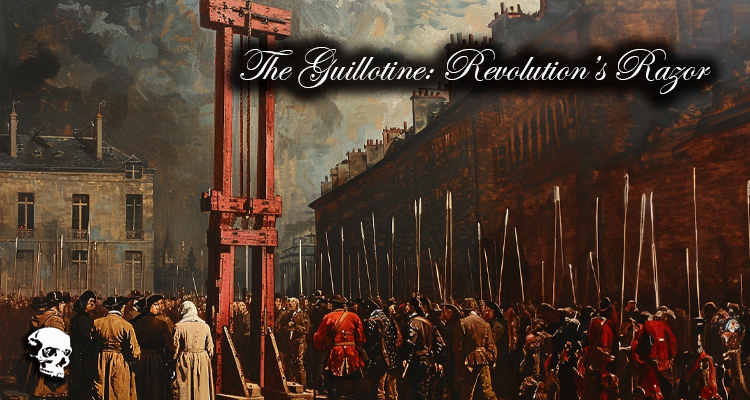Currently Empty: $0.00

The Guillotine: Revolution’s Razor
What is the Guillotine?
Symbol of Terror and Spectacle
The guillotine was not merely an execution device; it was a form of public spectacle and collective vengeance. Its use during the Revolution highlighted the intersection of popular violence and state-sanctioned executions. The public executions became a form of entertainment, drawing large crowds who gathered to witness the demise of those deemed enemies of the state. This spectacle served multiple purposes: it acted as a warning to those who might oppose the revolution, reinforced the power of the revolutionary government, and allowed the populace to participate in the enactment of justice.
The guillotine’s role extended beyond its practical function to become a tool of terror. The regular and public nature of the executions created an atmosphere of fear and uncertainty, essential for maintaining control during the tumultuous period of the Revolution. The spectacle of the guillotine also played into the narrative of collective vengeance, where the people’s justice was meted out against those perceived as traitors and oppressors.
Cultural Iconography
Artists and satirists of the time, such as James Gillray, extensively depicted the guillotine, often using imagination rather than factual details. This highlights the guillotine’s role as a potent symbol beyond its physical reality. Gillray’s works, filled with dark humor and biting commentary, emphasized the grotesque and macabre aspects of the guillotine, cementing its place in the cultural iconography of the era.
The guillotine’s imagery extended far beyond France, influencing perceptions and artistic representations across Europe. These artistic depictions contributed to the guillotine’s mythos, making it a symbol not just of French revolutionary justice, but of the broader anxieties and horrors associated with revolutionary change. The device became an icon of radicalism, often depicted in exaggerated forms to criticize the excesses of the Revolution and its leaders.
Dr. Guillotin’s Legacy
Contrary to popular belief, Dr. Joseph-Ignace Guillotin did not invent the guillotine but advocated for its use to ensure equal and less painful executions. Dr. Guillotin was a physician and a member of the National Assembly who, in 1789, proposed the use of a standardized and humane method of execution. His proposal aimed to eliminate the disparities in execution methods that varied according to social class, thus embodying the revolutionary principle of equality before the law.
Dr. Guillotin’s contributions are often misunderstood. The device was named after him not because he invented it, but because of his advocacy for its use. The actual design was the work of Dr. Antoine Louis and German engineer Tobias Schmidt. Dr. Guillotin’s association with the device has unfairly overshadowed his broader humanitarian efforts, and he spent much of his later life trying to distance his name from the machine that bore it.
Public Executions and Sentimentalism
The guillotine was designed to be an unfailing technology that rationalized punishment, aiming to be more humane and to minimize the psychological impact of executions on the public. Its proponents argued that it was a swift and painless method of execution, unlike the brutal and often botched beheadings that were common before its introduction. The device symbolized the Enlightenment belief in reason and science, applying technological precision to the act of execution.
The guillotine’s design was intended to reduce the horror of public executions. By standardizing the process, it was thought that the emotional and psychological impact on both the condemned and the spectators would be lessened. However, the reality often contradicted these intentions. The sheer number of executions during the Reign of Terror and the public’s desensitization to the violence led to a different kind of psychological impact—one of normalization of state violence and death.
Impact on Collective Memory
The imagery and memory of the guillotine persisted long after the Revolution, affecting collective memory and cultural representations in post-Revolutionary France. The guillotine became a symbol of the excesses of the Revolution, embodying both its ideals and its most violent contradictions. It featured prominently in literature, art, and popular culture, often representing the darker aspects of human nature and the perils of radical political change.
The guillotine’s legacy continued to shape French society’s understanding of its revolutionary past. The device became a potent symbol in the collective memory, evoking both the hope and the horror of the Revolution. It served as a reminder of the dangers of unchecked power and the thin line between justice and terror. The guillotine’s enduring presence in cultural memory underscores its role as a symbol of the profound and often painful transformations that the Revolution brought about.
The Reign of Terror
During the Reign of Terror, the guillotine was used to execute thousands, including prominent figures like Louis XVI and Marie Antoinette. This period, from 1793 to 1794, was marked by intense political purges and mass executions. The revolutionary government, led by the Committee of Public Safety under Maximilien Robespierre, sought to eliminate any perceived threats to the Revolution. The guillotine became the primary tool for this purge, symbolizing the radical and violent measures taken to protect the fledgling republic.
The device was used to execute not only members of the old aristocracy but also former revolutionaries who had fallen out of favor. The rapid and indiscriminate nature of the executions contributed to an atmosphere of fear and paranoia, where accusations and denunciations could lead to the guillotine.
The execution of Louis XVI in January 1793 and Marie Antoinette in October 1793 were particularly significant, marking the definitive break with the monarchy and the ancient regime. These high-profile executions underscored the revolutionary government’s commitment to radical change and the establishment of a new social order. The guillotine’s blade fell on both the high-born and the commoner, embodying the revolutionary ideal of equality in death.
